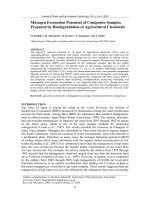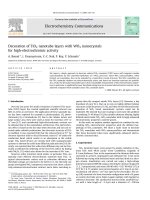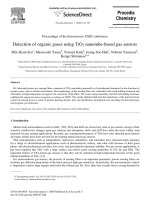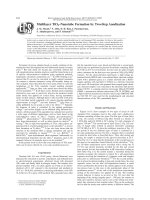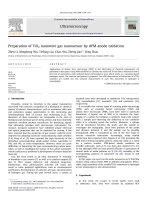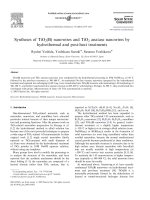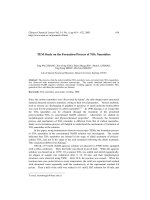- Trang chủ >>
- Khoa Học Tự Nhiên >>
- Vật lý
multilayer tio2 – nanotube formation by two-step anodization
Bạn đang xem bản rút gọn của tài liệu. Xem và tải ngay bản đầy đủ của tài liệu tại đây (569.74 KB, 4 trang )
Multilayer TiO
2
–Nanotube Formation by Two-Step Anodization
J. M. Macak,
*
S. Albu, D. H. Kim, I. Paramasivam,
S. Aldabergerova, and P. Schmuki
**
,z
Department of Materials Science, University of Erlangen–Nuremberg, D-91058 Erlangen, Germany
In this work we report on the growth of a closely stacked double layer of a self-organized TiO
2
nanotubes. For that we first anodize
Ti in acidic electrolyte containing hydrofluoric acid to form thin nanotube layers. Afterwards we start a second anodization in a
different electrolyte, a glycerol/NH
4
F mixture. This procedure allows us to grow the second layer directly underneath the first one.
From scanning electron microscopy and transmission electron microscopy investigations we revealed that the second growth
occurs via the tube bottoms of the first layer. These stacked multilayers generate new possibilities to vertically tailor the properties
of the self-organized TiO
2
nanotube layers.
© 2007 The Electrochemical Society. ͓DOI: 10.1149/1.2737544͔ All rights reserved.
Manuscript submitted February 5, 2007; revised manuscript received April 8, 2007. Available electronically May 15, 2007.
Formation of porous alumina based on anodic oxidation of alu-
minium has been investigated and well understood already for many
years.
1,2
But only about one decade ago, extremely ordered and
self-organized porous alumina structures could be formed using a set
of specific electrochemical conditions using optimized potential,
temperature, electrolyte composition, etc.
3-7
In 1999, Zwilling et al.
8
showed that Ti can also be converted to highly ordered nanotubes
͑in contrast to alumina nanopores͒ using self-assembly during an-
odic oxidation. Since then there have been many efforts to tailor the
morphology of the TiO
2
nanotube toward enabling potential
applications.
9-13
Later on, other valve metals have shown the ability
to form nanotubes.
14-16
In all these works, fluoride-anion-containing
electrolytes were used to selectively dissolve the anodized metals
under anodic bias applied for several hours, leaving nanotubular
layers on their surfaces. Although there is still very little work done
on Ti and other metals compared to Al, reports showing significant
improvements in length
9-13
and tube diameter
17,18
have been re-
cently published by our group as well as by others.
19,20
Typically,
the diameter of tubes is controlled by the applied anodization
voltage
17
and various lengths can be obtained using different elec-
trolytes. All these anodic TiO
2
nanotubes have already been used for
a wide range of different applications, such as those based on the
semiconductive nature of TiO
2
.
21
Namely, dye-sensitization,
22
doping,
23-25
photocatalysis,
26
electrochromism,
27
and photolysis
28
have been demonstrated, as well as others based on catalysis
29
or
sensing.
30
Due to high biocompatibility of TiO
2
, other reports tar-
geted growth of a hydroxyapatite layer on the nanotubes
31
as well as
their formation on Ti alloys.
32,33
It has also been shown that the
structure of the anodized tubes is always amorphous and can be
converted by annealing to anatase
21,34,35
or, e.g., BaTiO
3
36
or
Ba͑Sr͒TiO
3
37
upon hydrothermal alkali treatment. Additionally, by
electrochemical deposition into the tubes,
38
properties such as the
magnetic behavior of nanotube layers can be modified.
39
In the present work we show that even multistacks of TiO
2
nano-
tubes can be grown directly by a two-step anodization process.
Experimental
Titanium foils ͑0.1 mm, 99.6% purity, Advent Materials͒ were
degreased by sonication in acetone, isopropanol, and methanol prior
to electrochemical experiments, afterward rinsed with deionized
͑DI͒ water, and finally dried in nitrogen stream. The samples were
pressed together with a Cu plate against an O-ring in an electro-
chemical cell ͑1cm
2
exposed to the electrolyte͒ and anodized at
20Vin1MH
2
SO
4
electrolytes containing hydrofluoric acid ͑HF͒
͑0.16 M͒ for 2 h to grow a 500 nm thick TiO
2
nanotube layer. After
this the nanotube layers were rinsed and dried and a second anod-
ization step was performed in glycerol electrolytes containing NH
4
F
͑0.27 M͒ at 20 V for several hours. In some cases ͑to achieve longer
tubes͒, substrates for the first layer were grown in ͑NH
4
͒
2
SO
4
/NH
4
F
mixtures. For the electrochemical experiments, a high-voltage po-
tentiostat Jaissle IMP 88 and a conventional three-electrode configu-
ration with a platinum gauze as a counter electrode and a Haber–
Luggin capillary with Ag/AgCl ͑1MKCl͒ as a reference electrode
were used. All electrolytes were prepared from reagent-grade chemi-
cals. Selected samples were sonicated in the ultrasonic bath ͑power
output 100 W͒. A scanning electron microscope ͑Hitachi FE-SEM
S4800͒, a transmission electron microscope ͑CM 30 T/STEM͒, and
a high-resolution transmission electron microscopy ͑HRTEM͒ Phil-
ips CM 300 UT were used for the morphological and structural
characterization of the TiO
2
nanotubular layers.
Results and Discussion
Figures 1A-1C show examples of two types of arrays of self-
organized TiO
2
nanotubes used in this study and a double-layer
structure consisting of these two types. The first type of layer ͑layer
1, Fig. 1A͒ consists of 500 nm long tubes formed in a mixture of
1MH
2
SO
4
and 0.16 M HF at 20 V during 2 h with a diameter of
approx. 100 nm.
40
The second type of layer ͑layer 2, Fig. 1B͒ con-
sists of longer tubes formed in glycerol electrolyte containing
0.27 M NH
4
F at 20 V. To form the multilayer structure of Fig. 1C,
the growth of the two different types of tubes is combined in a
two-step anodization process. For this, a titanium sheet is anodized
to make the short tubes as described above. Then, after rinsing and
drying, the sample is anodized in the glycerol electrolyte at 20 V.
From Fig. 1C it is clear that the dimensions of the second layer are
the same as for nanotubes formed directly in this electrolyte.
12
Fig-
ure 1D shows polarization curves ͑recorded with a sweep rate of
0.1 V/s͒ and current transients recorded for the first and second
layer growth. For the first anodization in HF electrolytes leading to
short tubes ͑Fig. 1A͒, the current reaches a maximum during the
potential sweeping; this situation is typical for a self-organization
sequence involving the formation of a compact oxide and irregular
pores prior to ordered pore formation.
10,40
For the second anodiza-
tion in glycerol solutions leading to long and smooth tubes, the same
sequence occurs, but the tube self-organization kinetics is much
slower and therefore the drop in the current appears in the anodiza-
tion process later, in this case in the potentiostatic phase of the
anodization process.
41
At the end of the anodization experiments,
stirring of the electrolytes was applied for 15 min. The resulting
current behavior is shown as an inset in Fig. 1D. Just after the
beginning of the stirring ͑angular speed ϳ150 rpm͒, the currents in
both cases started to increase, and as soon as the stirring was termi-
nated, they returned to their original values. This can be ascribed to
the fact that the steady-state current density is diffusion limited. The
*
Electrochemical Society Student Member.
**
Electrochemical Society Active Member.
z
E-mail:
Electrochemical and Solid-State Letters, 10 ͑7͒ K28-K31 ͑2007͒
1099-0062/2007/10͑7͒/K28/4/$20.00 © The Electrochemical Society
K28
Downloaded 21 Jul 2008 to 159.226.100.134. Redistribution subject to ECS license or copyright; see />reason for the smaller increase in the glycerol electrolyte can be
ascribed to a significantly longer diffusion path ͑longer tubes͒ and to
the high viscosity of the electrolyte.
In order to evaluate the growth of the second layer after the first
layer has been formed, we performed detailed scanning electron
microscopy ͑SEM͒ investigations of the interfaces between the lay-
ers. Figure 2 shows a scheme of the formation of second-layer
growth, which is based on the SEM observation shown in Fig. 3. We
first grow an initial nanotube layer in the acidic electrolyte ͑Fig. 2a͒.
Afterwards we clean and dry it, immerse it in the glycerol electro-
lyte, and start the second anodization process. After several minutes,
there are very small channels or holes etched in the bottoms of the
first tube layer ͑Fig. 2b͒. The etching takes place preferentially at the
bottom of the tubes. From the images in Fig. 3A and 3B that were
taken from sample anodized for about 20 min in the glycerol elec-
trolyte ͑to form the second layer͒, it is evident that the etching front
penetrates the bottoms and new and somewhat irregularly distrib-
uted tubes are formed ͑Fig. 2c͒. The new tubes are at this very
moment competing for available space and current. Growth of some
tubes is terminated after a while, because there is not sufficient
space available. After about 40 min, the newly formed tubes are
already self-organized ͑Fig. 2d͒, with only small variations in diam-
eter ͑40 ± 10 nm͒ as shown also in Fig. 3C. From the images in Fig.
3A and 3B it can be seen that the width of the channels drawn in
Fig. 2c is in the range between 15 and 25 nm. The number of chan-
nels is typically between 3 and 5 and the number of the newly
formed tubes from the first layer ͑one bigger tube͒ is3or4,as
shown also in Fig. 2d. From Fig. 1A it can be seen that the original
outer diameter of the tubes ͑layer 1͒ was about 130 nm and the
newly formed tubes ͑layer 2͒ in Fig. 1B have outer diameters of
Figure 1. SEM top-view images of the tubes used for the growth of ͑A͒ the first and ͑B͒ the second layer and ͑C͒ their interface after two-step anodization. The
first tubes are 500 nm long with a diameter of 100 ± 10 nm, and the second tubes have a diameter of 40 ± 10 nm and length dependent on the anodization time;
͑D͒ polarization curves ͑left part, sweep rate 0.1 V/s͒ and current transients ͑right part͒ recorded for anodization of Ti sample at 20 V during the first layer
growth ͑in acidic electrolyte͒ and during the second layer growth ͑in glycerol electrolyte͒. ͑Insets͒ Magnification of the current transients during electrolyte
strirring introduced for 15 min ͑angular speed ϳ150 rpm͒.
Figure 2. Schematic drawing demonstrating four steps in the formation of
the second tubular layer during the second anodization step.
K29Electrochemical and Solid-State Letters, 10 ͑7͒ K28-K31 ͑2007͒ K29
Downloaded 21 Jul 2008 to 159.226.100.134. Redistribution subject to ECS license or copyright; see />50 ± 10 nm. Using a longer tube geometry ͑more than 500 nm͒ as
the upper nanotube layer is possible, but wetting of such tubes after
drying becomes a more severe issue. Remarkably, there is no sig-
nificant chemical dissolution apparent of either the first layer or the
second layer. One can expect that the electrolyte also filled the space
between the nanotubes; however, it seems that the gaps of the first
tube layer not the most reactive sites under present conditions, as we
did not observe any nanotube growth there.
To obtain more insight into the formation of the second layer, we
performed some additional characterization by TEM. Figure 4
shows TEM images of the second-layer nanotubes ͑A͒ and a single
tube ͑B͒ of the first layer, with several channels at the bottom de-
scribed and shown in Fig. 2 and 3. From Fig. 4A one can clearly see
that the second-layer tubes are smooth and without ripples on the
walls. Furthermore, the presence of open channels for mass and
current flow from the first to the second layer is confirmed by Fig.
4B. Figure 4C shows a high-resolution TEM image of the tube bot-
tom of the second layer. Clearly, an amorphous structure is present
as confirmed by selected area diffraction pattern ͑SAED͒, shown in
the inset.
Figure 5 shows the influence of anodization time on the thickness
of the second layer. After 10 min of anodization there are only short
Figure 3. SEM images of the interface between both TiO
2
nanotubular lay-
ers ͑A͒ in the top- and ͑B͒ in the cross-sectional view showing channels at
the bottoms of the first layer; ͑C͒ comparison between the tube outer diam-
eters during the transition from one ͑outer diameter approximately 130 nm͒
to the other type ͑approx. 70 nm͒. Space occupied originally by one tube is
typically used for three tubes of the second layer.
Figure 4. ͑A͒ TEM images of bundles of smooth TiO
2
nanotubes from the
second layer; ͑B͒ single tube depicted from the top showing etched bottom
with channels; ͑C͒ HRTEM image of the tube bottom of the second type
showing amorphous structure. Inset in c shows SAED with diffuse rings
matching amorphous structure.
Figure 5. Dependence of the second-layer thickness on the anodization time
during the second anodization step shown ͑a͒ as a sequence of SEM cross-
sectional images and ͑b͒ as a plot. Linear growth with constant of 300 nm/h
is achieved within first 12 h.
K30 Electrochemical and Solid-State Letters, 10 ͑7͒ K28-K31 ͑2007͒K30
Downloaded 21 Jul 2008 to 159.226.100.134. Redistribution subject to ECS license or copyright; see />tubes; no visible alteration of the tube bottoms has occurred. After
approximately 30 min of anodization there is already a second tube
layer formed with a thickness of about 100 nm. The tubes keep
growing and the tube layer thickness increases with time as shown
in Fig. 5b. In the early stages ͑first 12 h͒, the thickness increases
linearly, and for longer times a deviation to an apparently slower
growth rate is observed. After 24 h of anodization the second tube
layer thickness is reaching 5 m. From the cross-sectional SEM
images we can estimate the growth rate in the early stages of ap-
proximately 50 nm per 10 min ͑300 nm per h͒. This means that the
growth of nanotubes with the same length is somewhat slower com-
pared to tubes that were grown directly,
12,41
i.e., without the pres-
ence of the upper tube layer. For example, in our previous work we
were able to grow 7 m tubes within 13 h under the same electro-
chemical conditions as used here.
12
This can be described to ham-
pered diffusion of the chemical species through the narrow channels
between the first and second layer. Multilayer structures, as formed
here, may have significant applications, for example, in size-
selective reactive filtration or Bragg-stack structures.
42,43
Conclusions
The results of the present work show that multilayer stacks of
highly ordered and self-organized TiO
2
nanotubular layers can be
grown by two-step anodization under different electrochemical con-
ditions. From SEM evaluation we revealed that the growth of tubes
of the second layer starts at the bottom of the first tubes by narrow
channels being formed in the early stages. Further, we show that the
thickness of these second layers can be in the range of several mi-
crometers, depending on anodization time. Clearly, the diameter of
the tubes corresponds to the formation conditions of the individual
nanotube layers. The growth of the second layer in length is some-
what slower than for its isolated formation. The feasibility to form
two distinct layers may be exploited in view of optical properties or
for size-selective reactions.
Acknowledgments
The authors acknowledge DFG for financial support. Hans Rollig
and Martin Kolacyak are acknowledged for valuable technical help.
University of Erlangen assisted in meeting the publication costs of this
article.
References
1. F. Keller, M. S. Huntler, and D. L. Robinson, J. Electrochem. Soc., 100,411
͑1953͒.
2. J. W. Diggle, T. C. Downie, and C. W. Goulding, Chem. Rev. (Washington, D.C.),
69, 365 ͑1969͒.
3. H. Masuda and K. Fukuda, Science, 268, 1466 ͑1995͒.
4. G. E. Thompson, Thin Solid Films, 297, 192 ͑1997͒.
5. O. Jessensky, F. Müller, and U. Gösele, J. Electrochem. Soc., 145, 3735 ͑1998͒.
6. S. Ono, M. Saito, and H. Asoh, Electrochim. Acta, 51, 827 ͑2005͒.
7. W. Lee, R. Ji, U. Gösele, and K. Nielsch, Nat. Mater., 5, 741 ͑2006͒.
8. V. Zwilling, E. Darque-Ceretti, and A. Boutry-Forveille, Electrochim. Acta, 45,
921 ͑1999͒.
9. J. M. Macak, K. Sirotna, and P. Schmuki, Electrochim. Acta, 50, 3679 ͑2005͒.
10. L. Taveira, J. M. Macak, H. Tsuchiya, L. F. P. Dick, and P. Schmuki, J. Electro-
chem. Soc., 152, B405 ͑2005͒.
11. J. M. Macak, H. Tsuchiya, and P. Schmuki, Angew. Chem., Int. Ed., 44, 2100
͑2005͒.
12. J. M. Macak, H. Tsuchiya, L. Taveira, S. Aldabergerova, and P. Schmuki, Angew.
Chem., Int. Ed., 44, 7463 ͑2005͒.
13. S. Albu, A. Ghicov, J. M. Macak, and P. Schmuki, Phys. Status Solidi (RRL), 1,
R65 ͑2007͒.
14. H. Tsuchiya, J. M. Macak, I. Sieber, and P. Schmuki, Small, 1, 722 ͑2005͒.
15. H. Tsuchiya and P. Schmuki, Electrochem. Commun., 7,49͑2005͒.
16. I. Sieber, B. Kannan, and P. Schmuki, Electrochem. Solid-State Lett., 8, J10
͑2005͒.
17. S. Bauer, S. Kleber, and P. Schmuki, Electrochem. Commun., 8, 1321 ͑2006͒.
18. H. Tsuchiya, J. M. Macak, L. Taveira, E. Balaur, A. Ghicov, K. Sirotna, and P.
Schmuki, Electrochem. Commun., 7, 576 ͑2005͒.
19. Q. Cai, M. Paulose, O. K. Varghese, and C. A. Grimes, J. Mater. Res., 20, 230
͑2005͒.
20. K. S. Raja, M. Misra, and K. Paramguru, Electrochim. Acta, 51, 154 ͑2005͒.
21. R. Beranek, H. Tsuchiya, T. Sugishima, J. M. Macak, L. Taveira, S. Fujimoto, H.
Kisch, and P. Schmuki, Appl. Phys. Lett., 87, 243114 ͑2005͒.
22. J. M. Macak, H. Tsuchiya, A. Ghicov, and P. Schmuki, Electrochem. Commun., 7,
1138 ͑
2005͒.
23. A. Ghicov, J. M. Macak, H. Tsuchiya, J. Kunze, V. Heaublein, L. Frey, and P.
Schmuki, Nano Lett., 6, 1080 ͑2006͒.
24. J. M. Macak, A. Ghicov, R. Hahn, H. Tsuchiya, and P. Schmuki, J. Mater. Res., 21,
2824 ͑2006͒.
25. J. H. Park, S. Kim, and A. J. Bard, Nano Lett., 6,24͑2006͒.
26. J. M. Macak, M. Zlamal, J. Krysa, and P. Schmuki, Small, 3, 303 ͑2007͒.
27. A. Ghicov, H. Tsuchiya, R. Hahn, J. M. Macak, and A. G. Munoz, Electrochem.
Commun., 8, 528 ͑2006͒.
28. O. K. Varghese, M. Paulose, K. Shankar, G. K. Mor, and C. A. Grimes, J. Nanosci.
Nanotechnol., 5, 1158 ͑2005͒.
29. J. M. Macak et al., Electrochem. Commun., 7, 1417 ͑2005͒.
30. O. K. Varghese, D. Gong, K. G. Ong, and C. A. Grimes, Sens. Actuators B, 93, 338
͑2003͒.
31. H. Tsuchiya, J. M. Macak, L. Muller, J. Kunze, F. Muller, S. P. Greil, S. Virtanen,
and P. Schmuki, J. Biomed. Mater. Res., 77A, 534 ͑2006͒.
32. H. Tsuchiya, J. M. Macak, A. Ghicov, and P. Schmuki, Small, 2, 888 ͑2006͒.
33. J. M. Macak, H. Tsuchiya, L. Taveira, A. Ghicov, and P. Schmuki, J. Biomed.
Mater. Res.
, 75A, 928 ͑2005͒.
34. O. K. Varghese, D. Gong, M. Paulose, C. A. Grimes, and E. Dickey, J. Mater. Res.,
18, 156 ͑2003͒.
35. J. M. Macak, S. Aldabergerova, A. Ghicov, and P. Schmuki, Phys. Status Solidi A,
203, R67 ͑2006͒.
36. N. T. Padture and X. Wei, J. Am. Ceram. Soc., 86, 2215 ͑2003͒.
37. X. Wei, A. L. Vasiliev, and N. P. Padture, J. Mater. Res., 20, 2140 ͑2005͒.
38. J. M. Macak, B. G. Gong, M. Hueppe, and P. Schmuki, Adv. Mater. (Weinheim,
Ger.), Accepted.
39. V. M. Prida, M. Hernández-Veléz, K. R. Pirota, A. Menéndez, and M. Vasquéz,
Nanotechnology, 16, 2696 ͑2005͒.
40. R. Beranek, H. Hildebrand, and P. Schmuki, Electrochem. Solid-State Lett., 6, B12
͑2003͒.
41. J. M. Macak and P. Schmuki, Electrochim. Acta, 52, 1258 ͑2006͒.
42. H. Tsuchiya, M. Hueppe, T. Djenizian, and P. Schmuki, Surf. Sci., 547, 268 ͑2003͒.
43. G. Vincent, Appl. Phys. Lett., 64, 2367 ͑1994͒.
K31Electrochemical and Solid-State Letters, 10 ͑7͒ K28-K31 ͑2007͒ K31
Downloaded 21 Jul 2008 to 159.226.100.134. Redistribution subject to ECS license or copyright; see />
